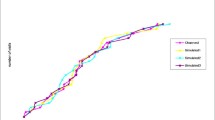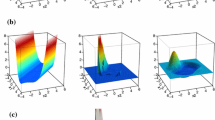Abstract
Van Valen’s test is usually applied as a two sample test for equality of dispersion for multivariate data. Motivated by a comment of Manly (Van Valen’s test. Encyclopedia of Statistical Sciences, 2006) that “Little is known about the properties of Van Valen’s test” we develop an alternative test and compare the Van Valen test with our alternative robust test in an extensive simulation study. We find that Van Valen’s test does not actually test for equality of variance sums; however, for that null hypothesis it still performs well in terms of closeness to the nominal significance level. Due to testing the correct null hypothesis and the excellent adherence to the nominal significance level, we recommend the use of the robust test as a permutation test.







Similar content being viewed by others
References
Anderson TW (2003) An introduction to multivariate analysis, 3rd edn. Wiley, New York
Bumpus HC (1898) The elimination of the unfit as illustrated by the introduced sparrow, passer domesticus. In: Biological Lectures. Marine Biology Laboratory, Woods Hole, pp 209–226
Chung E, Romano JP (2016) Multivariate and multiple permutation tests. J Econ 193(1):76–91
Harris P (1985) Testing for variance homogeneity of correlated variables. Biometrika 72(1):103–107
Joarder A, Singh S (2001) Estimation of the trace of the scaled covariance matrix of a multivariate t-model using a known information. Metrika 54:53–58
Manly BFJ (2005) Multivariate statistical methods: a primer, 3rd edn. Chapman and Hall, London
Manly BFJ (2006) Van Valen’s test. Encyclopedia of Statistical Sciences
Satterthwaite F (1941) Synthesis of variance. Psychometrika 6(5):309–316
Satterthwaite FE (1946) An approximate distribution of estimates of variance components. Biometrics Bull 2(6):110–114
Seber GAF (1984) Multivariate observations. Wiley, New York
Stuart A, Ord K (1994) Kendall’s advanced theory of statistics, distribution theory, vol 1, 6th edn. Holder Arnold, London
Van Valen L (1974) Multivariate structural statistics in natural history. J Theoret Biol 45(1):235–247
Van Valen L (1978) The statistics of variation. Evolut Theory 4:33–43
Acknowledgements
The authors thank the extraordinary efforts of the reviewer whose comments and feedback have greatly improved the paper.
Author information
Authors and Affiliations
Corresponding author
Additional information
Handling Editor: Luiz Duczmal.
Appendix: Sum of squares of the robust test statistic
Appendix: Sum of squares of the robust test statistic
The robust analogue is based on the variable sample variances \( S^2_{jk} = \frac{\sum _{i=1}^{n_j} \left( X_{ijk} - {\bar{X}}_{\bullet jk} \right) ^2 }{n_j - 1} \) and in particular on the sum of these, \(\sum _{k=1}^{p} S^2_{jk}\). It is important here to not confuse \(S_j^2\) and \(S_{jk}^2\). The numerator in the robust analogue is the square of \(\sum _{k=1}^{p} S^2_{1k} - \sum _{k=1}^{p} S^2_{2k}\). Now
and hence
The denominator of the robust analogue is equivalent to \( {\varvec{1}}_p^T \hat{\varvec{\varOmega }}_1 {\varvec{1}}_p + {\varvec{1}}_p^T \hat{\varvec{\varOmega }}_2 {\varvec{1}}_p\) with
where, as before, \( {n_j} m^{rs}_{jkl} = \sum _{i=1}^{n_j} \left( X_{ijk} - {\bar{X}}_{\bullet jk} \right) ^r \left( X_{ijl} - {\bar{X}}_{\bullet jl} \right) ^s \). We seek to express these in terms of \(D_{ij}\). Now \(\sum _{i=1}^{n_j} \left( D_{ij} - {\bar{D}}_{ij}\right) ^2 = \sum _{i=1}^{n_j} D_{ij}^2 - n_j {\bar{D}}_j^2\). First
Next,
Therefore
and \(S_j^2 = \frac{n_j^2 {\varvec{1}}_p^T \hat{\varvec{\Omega }}_j {\varvec{1}}_p }{n_j - 1}\), so \( {\varvec{1}}_p^T \hat{\varvec{\varOmega }}_j {\varvec{1}}_p = \frac{\left( n_j - 1\right) S_j^2}{n_j^2}\). Thus the denominator in the robust analogue is \( {\varvec{1}}_p^T \hat{\varvec{\varOmega }}_1 {\varvec{1}}_p + {\varvec{1}}_p^T \hat{\varvec{\varOmega }}_2 {\varvec{1}}_p = \frac{\left( n_1 - 1\right) S_1^2}{n_1^2} + \frac{\left( n_2 - 1\right) S_2^2}{n_2^2}\). Combining these the robust analogue is
Rights and permissions
About this article
Cite this article
Livingston, G., Allingham, D. & Rayner, J.C.W. Tests for aggregated dispersion: Van Valen’s test and a new competitor. Environ Ecol Stat 29, 223–239 (2022). https://doi.org/10.1007/s10651-021-00517-0
Received:
Revised:
Accepted:
Published:
Issue Date:
DOI: https://doi.org/10.1007/s10651-021-00517-0




